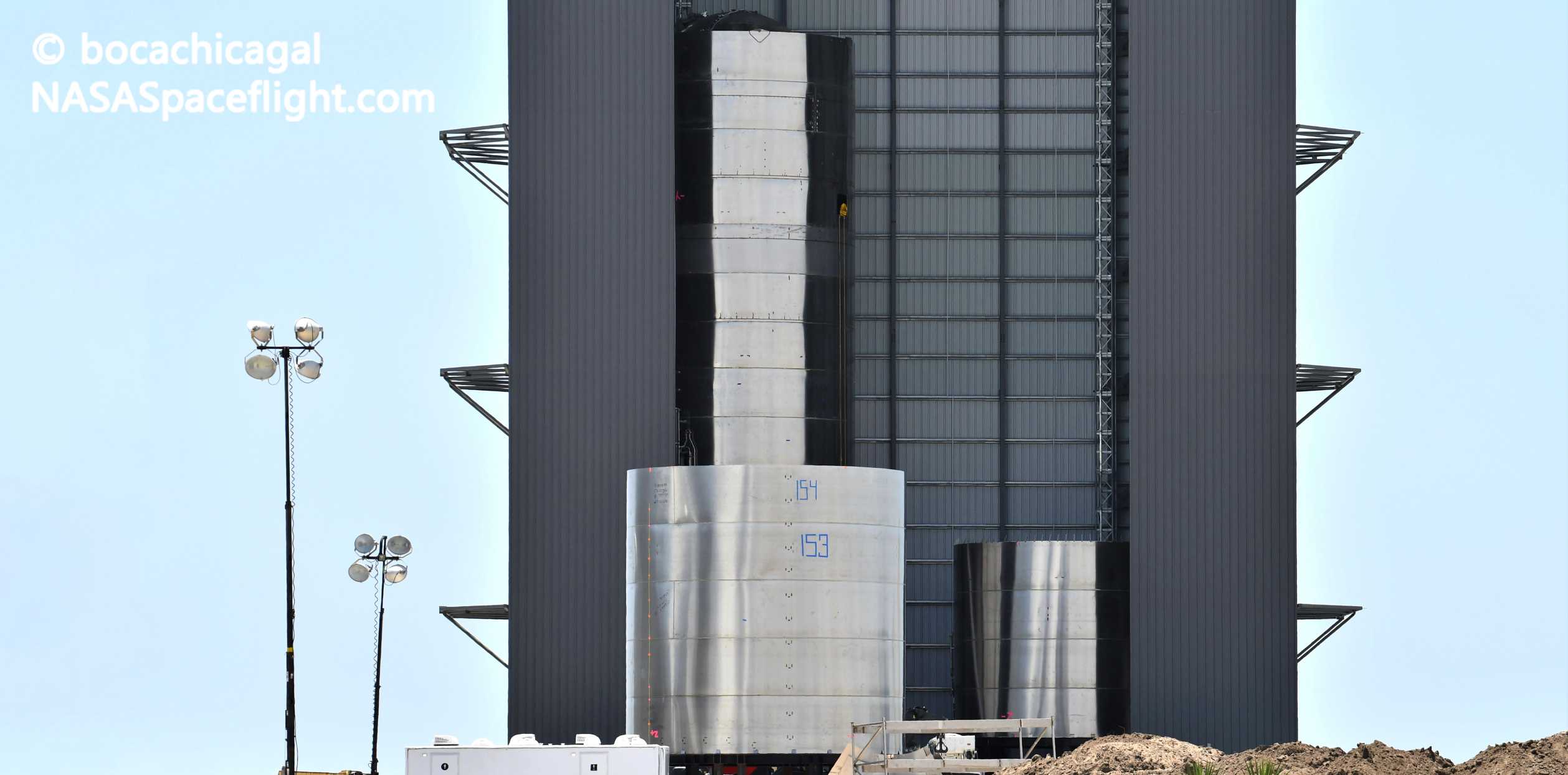
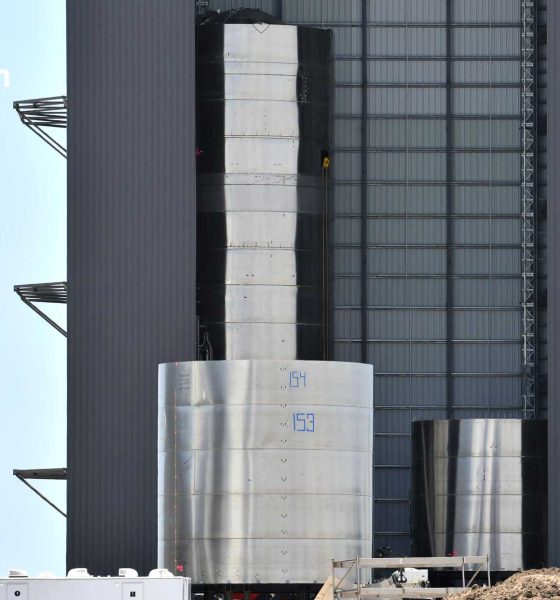
News
SpaceX’s Starship factory is churning out steel rockets faster than ever
SpaceX’s South Texas Starship factory is churning out steel rocket hardware faster than ever before according to photos of yet another prototype already in the works.
At the same time as SpaceX works around the clock to test SN4 and prepare the ship for what will be the first flight of a full-scale Starship prototype, the company is building not one; not two; but three additional prototypes. A confirmation that a third Starship was being simultaneously manufactured in South Texas came on May 25th when local Boca Chica resident and observer Mary (bocachicagal) captured a photo of a pair of stacked steel rings rather conspicuously labeled “SN7”.
While it’s possible that “SN7” is just a coincidence, it’s far more likely that it refers to Starship serial number 7 (SN7), set to be the seventh full-scale prototype built by SpaceX. The apparent start of SN7’s steel ring assembly process some two weeks ago also suggests that no less than several other rings are likely being mated in one or more of SpaceX’s three main manufacturing tents or a much taller windbreak structure. In fact, SpaceX is building Starship prototypes so quickly that the company is actively assembling a second launch mount, suggesting that two Starships could soon be tested more or less simultaneously without stepping on each other’s steel toes.
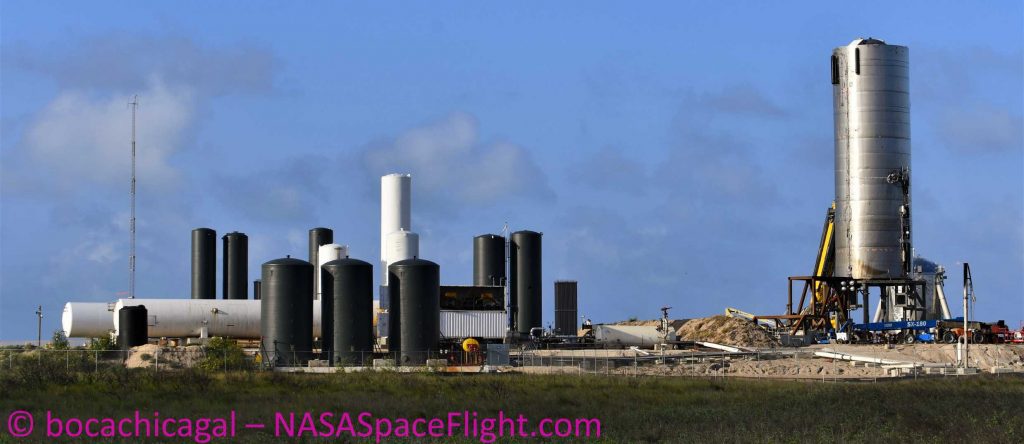
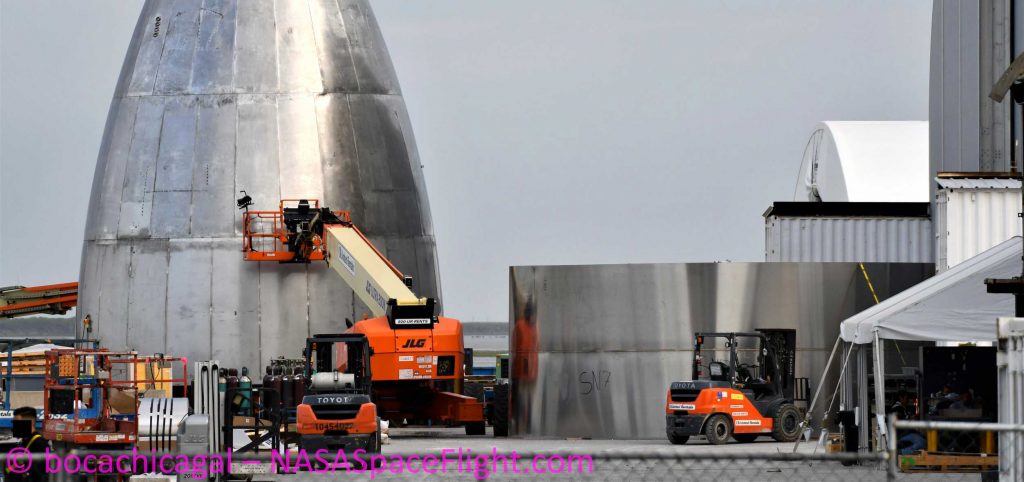
The most impressive aspect of SN7’s appearance, however, is the fact that SpaceX is already in the late stages of stacking Starship SN5 and begun preparing to stack Starship SN6 directly beside it just a few days ago. Based on labels attached to the side of a new steel nosecone section rolled out of SpaceX’s tent factory a few days ago, Starship SN5 will likely become the first full-scale Starship to reach its full height in a permanent, functional fashion. Back in October 2019, SpaceX did technically stack Starship Mk1 to its full height for a few weeks, but the ship’s nose section was never permanently attached and really only served as a pathfinder and full-scale mockup.
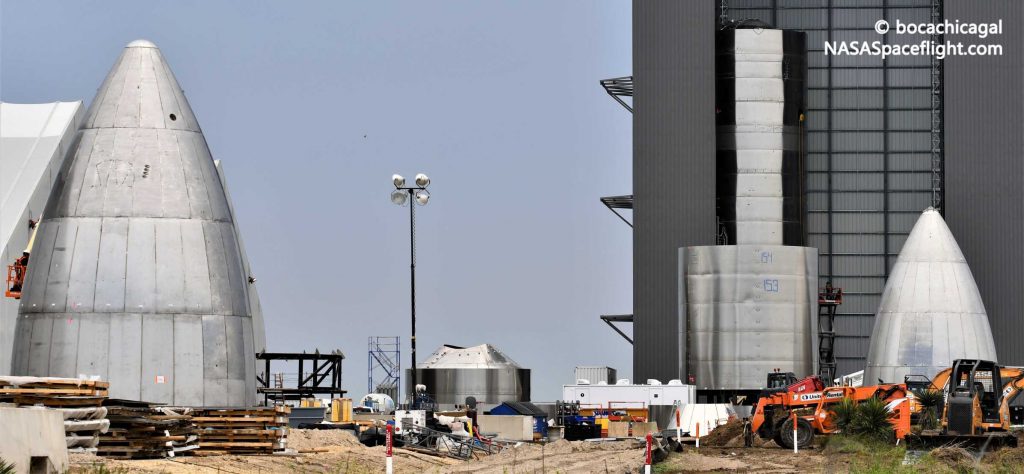
Starship Mk1 ultimately failed prematurely during its first major cryogenic pressure test in November 2019, bursting well before it reached the tank pressures needed for low-velocity hop tests (let alone orbital flight). In the sixth months since, SpaceX refocused its resources and spent much of the time dramatically upgrading its South Texas Starship production facilities and methods. In a rapid-fire series of tests of custom-built Starship tanks, SpaceX quickly proved that those improved methods could produce steel tanks more than capable of surviving pressures of ~8.5 bar (~125 psi) and beyond.
More recently, Starship SN4 – a full-scale prototype with two propellant tanks and three tank domes – passed a ~7.5 bar (~110 psi) cryogenic pressure test with flying colors, just shy of fully validating the smaller tank tests that made it possible. According to CEO Elon Musk, ~8.5 bar is enough to perform orbital launches with the ~40% safety margin preferred for human spaceflight, while 7.5 bar meets the minimum needed for Starship to perform uncrewed orbital launches with a ~25% safety margin.
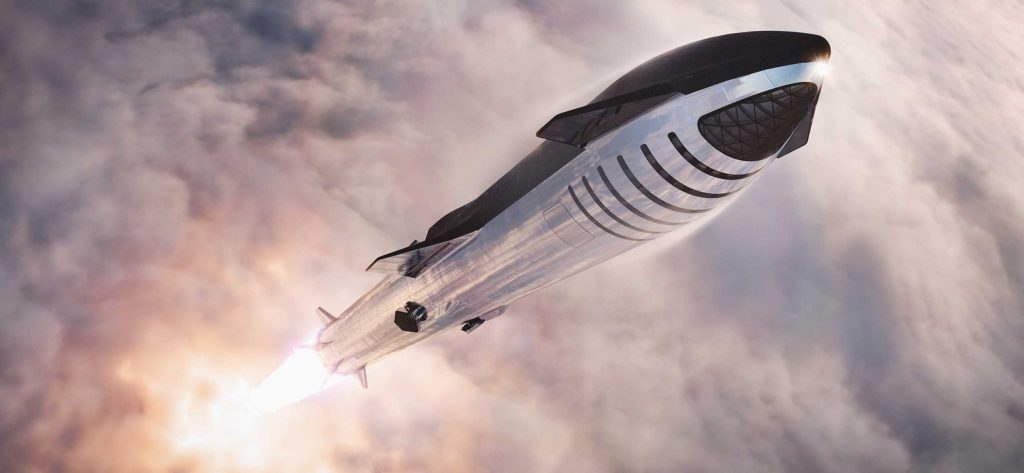
In other words, SpaceX isn’t simply churning out low-fidelity prototypes – the ships that are being mass-produced are of a high enough quality to be qualified for orbital-class launches. Of course, the physical structure of Starship is just one of many technologies that need to work in harmony for successful orbital flights, many of which need to pass their own challenging tests to be declared ready for launch, but it’s still undeniably impressive that SpaceX is already building complete Starship fuselages in a matter of weeks.
In fact, given that Starship SN4 could perform the first hop test and that SN5 could be assigned to the first high-altitude (3-20+ km) flight tests, there is definitely a chance, however minimal, that Starship SN6 or SN7 could eventually be upgraded for the system’s inaugural orbital launch attempt. Regardless, it’s safe to say that the next several weeks are going to be jam-packed with numerous Starship production and test milestones.
Check out Teslarati’s Marketplace! We offer Tesla accessories, including for the Tesla Cybertruck and Tesla Model 3.

Elon Musk
SpaceX issues statement on Starship V3 Booster 18 anomaly
The incident unfolded during gas-system pressure testing at the company’s Massey facility in Starbase, Texas.

SpaceX has issued an initial statement about Starship Booster 18’s anomaly early Friday. The incident unfolded during gas-system pressure testing at the company’s Massey facility in Starbase, Texas.
SpaceX’s initial comment
As per SpaceX in a post on its official account on social media platform X, Booster 18 was undergoing gas system pressure tests when the anomaly happened. Despite the nature of the incident, the company emphasized that no propellant was loaded, no engines were installed, and personnel were kept at a safe distance from the booster, resulting in zero injuries.
“Booster 18 suffered an anomaly during gas system pressure testing that we were conducting in advance of structural proof testing. No propellant was on the vehicle, and engines were not yet installed. The teams need time to investigate before we are confident of the cause. No one was injured as we maintain a safe distance for personnel during this type of testing. The site remains clear and we are working plans to safely reenter the site,” SpaceX wrote in its post on X.
Incident and aftermath
Livestream footage from LabPadre showed Booster 18’s lower half crumpling around the liquid oxygen tank area at approximately 4:04 a.m. CT. Subsequent images posted by on-site observers revealed extensive deformation across the booster’s lower structure. Needless to say, spaceflight observers have noted that Booster 18 would likely be a complete loss due to its anomaly.
Booster 18 had rolled out only a day earlier and was one of the first vehicles in the Starship V3 program. The V3 series incorporates structural reinforcements and reliability upgrades intended to prepare Starship for rapid-reuse testing and eventual tower-catch operations. Elon Musk has been optimistic about Starship V3, previously noting on X that the spacecraft might be able to complete initial missions to Mars.
Investor's Corner
Tesla analyst maintains $500 PT, says FSD drives better than humans now
The team also met with Tesla leaders for more than an hour to discuss autonomy, chip development, and upcoming deployment plans.

Tesla (NASDAQ:TSLA) received fresh support from Piper Sandler this week after analysts toured the Fremont Factory and tested the company’s latest Full Self-Driving software. The firm reaffirmed its $500 price target, stating that FSD V14 delivered a notably smooth robotaxi demonstration and may already perform at levels comparable to, if not better than, average human drivers.
The team also met with Tesla leaders for more than an hour to discuss autonomy, chip development, and upcoming deployment plans.
Analysts highlight autonomy progress
During more than 75 minutes of focused discussions, analysts reportedly focused on FSD v14’s updates. Piper Sandler’s team pointed to meaningful strides in perception, object handling, and overall ride smoothness during the robotaxi demo.
The visit also included discussions on updates to Tesla’s in-house chip initiatives, its Optimus program, and the growth of the company’s battery storage business. Analysts noted that Tesla continues refining cost structures and capital expenditure expectations, which are key elements in future margin recovery, as noted in a Yahoo Finance report.
Analyst Alexander Potter noted that “we think FSD is a truly impressive product that is (probably) already better at driving than the average American.” This conclusion was strengthened by what he described as a “flawless robotaxi ride to the hotel.”
Street targets diverge on TSLA
While Piper Sandler stands by its $500 target, it is not the highest estimate on the Street. Wedbush, for one, has a $600 per share price target for TSLA stock.
Other institutions have also weighed in on TSLA stock as of late. HSBC reiterated a Reduce rating with a $131 target, citing a gap between earnings fundamentals and the company’s market value. By contrast, TD Cowen maintained a Buy rating and a $509 target, pointing to strong autonomous driving demonstrations in Austin and the pace of software-driven improvements.
Stifel analysts also lifted their price target for Tesla to $508 per share over the company’s ongoing robotaxi and FSD programs.
Elon Musk
SpaceX Starship Version 3 booster crumples in early testing
Photos of the incident’s aftermath suggest that Booster 18 will likely be retired.

SpaceX’s new Starship first-stage booster, Booster 18, suffered major damage early Friday during its first round of testing in Starbase, Texas, just one day after rolling out of the factory.
Based on videos of the incident, the lower section of the rocket booster appeared to crumple during a pressurization test. Photos of the incident’s aftermath suggest that Booster 18 will likely be retired.
Booster test failure
SpaceX began structural and propellant-system verification tests on Booster 18 Thursday night at the Massey’s Test Site, only a few miles from Starbase’s production facilities, as noted in an Ars Technica report. At 4:04 a.m. CT on Friday, a livestream from LabPadre Space captured the booster’s lower half experiencing a sudden destructive event around its liquid oxygen tank section. Post-incident images, shared on X by @StarshipGazer, showed notable deformation in the booster’s lower structure.
Neither SpaceX nor Elon Musk had commented as of Friday morning, but the vehicle’s condition suggests it is likely a complete loss. This is quite unfortunate, as Booster 18 is already part of the Starship V3 program, which includes design fixes and upgrades intended to improve reliability. While SpaceX maintains a rather rapid Starship production line in Starbase, Booster 18 was generally expected to validate the improvements implemented in the V3 program.
Tight deadlines
SpaceX needs Starship boosters and upper stages to begin demonstrating rapid reuse, tower catches, and early operational Starlink missions over the next two years. More critically, NASA’s Artemis program depends on an on-orbit refueling test in the second half of 2026, a requirement for the vehicle’s expected crewed lunar landing around 2028.
While SpaceX is known for diagnosing failures quickly and returning to testing at unmatched speed, losing the newest-generation booster at the very start of its campaign highlights the immense challenge involved in scaling Starship into a reliable, high-cadence launch system. SpaceX, however, is known for getting things done quickly, so it would not be a surprise if the company manages to figure out what happened to Booster 18 in the near future.








